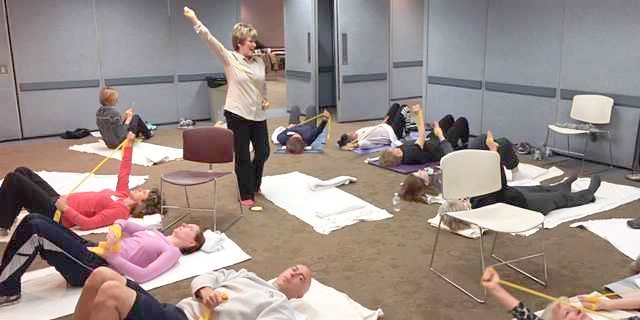
According to the Parkinson’s Foundation, orthostatic hypotension (OH) affects 15 to 50% of people with Parkinson disease (PWP). The medical definition of orthostatic hypotension is a drop in systolic blood pressure of greater than 20 mmHg or a drop in diastolic blood pressure of greater than 10 mmHg within 3 minutes of standing. Additionally, consideration is taken to the heart rate increase upon standing and if less than 10-15 beats per minute, it may be indicative of OH.
One of the many lifestyle modifications given is to increase fluid intake. Increasing fluids for blood pressure management to reduce dizziness, syncope, and fall risk from OH can be very challenging for this population. Many PWP present with significant self-imposed fluid restrictions as they try to manage common issues with bladder urgency frequency. Getting ½ their body weight in ounces or the traditional recommendation of 8 glasses a day may feel overwhelming. A common recommendation from their neurologist or other health care providers is to have 16 ounces of fluid right away in the morning. Research has shown this to help individuals with autonomic nervous system/baroreflex dysfunction to have rapid symptomatic improvement eliciting a water-induced pressure response and raising their blood pressure. In PWP with autonomic dysfunction, the baroreceptors, which constrict to increase heart rate and blood pressure upon standing, are sluggish to respond similar to the slowness of movement observed in a PWP. Individualized and creative daytime urge control techniques, bladder retraining, timed voiding, measured bladder diary assessment, constipation management strategies, and neuromodulation strategies are crucial to maintaining quality of life in coordination with fall safety related to OH.
For those with OH who also struggle with nocturia, the shifting of fluids to earlier in the day may require closer monitoring of blood pressure to ensure our advice is safe. The Wisconsin Parkinson Association’s director of medical advising and education, Dacy Reimer, APNP, describes the recommended blood pressure tracking methods for reporting back to neurology. With the use of an electronic blood pressure cuff, blood pressure, pulse, and symptoms can be recorded after sitting for 5 minutes and a second blood pressure after standing for 3 minutes. This can be regularly tracked once in the morning and once at night. If we are giving advice for fluid management changes to modify bladder behavior, we may want our patients to monitor this at additional times throughout the day. Many of my patients who report nocturia at their evaluation, have already tried the common recommendation of stopping fluids 2-3 hours before bed without a change in their symptoms. A more aggressive fluid shifting plan, where the person will still be asked to get their recommended fluids each day, but achieve that goal much earlier, with a more dramatic tapering at the end of the day has clinically shown benefit. Trying to fill the bladder more during the day to allow for sensory training/larger fill volumes as well as to flip the circadian rhythm for urine production is the goal. Monitoring blood pressure as an additional component of the bladder diary, while your patient makes suggested changes, can ensure their safety.
If additional nuances to the pelvic health complexities involved in Parkinson disease interest you, come delve into it with me even further in my course - Parkinson Disease and Pelvic Rehabilitation scheduled for April 25-26 2025.
Resources:
- Ramsay, S., & Zagorodnyuk, V. (2023). Role of circadian rhythms and melatonin in bladder function in heath and diseases. Autonomic neuroscience, 246, 103083.
- Shannon, J. R., Diedrich, A., Biaggioni, I., Tank, J., Robertson, R. M., Robertson, D., & Jordan, J. (2002). Water drinking as a treatment for orthostatic syndromes. The American journal of medicine, 112(5), 355-360.
AUTHOR BIO:
Erica Vitek, MOT, OTR, BCB-PMD, PRPC
 Erica Vitek, MOT, OTR, BCB-PMD, PRPC (she/her) graduated with her master’s degree in Occupational Therapy from Concordia University Wisconsin in 2002 and works for Aurora Health Care at Aurora Sinai Medical Center in downtown Milwaukee, Wisconsin. Erica specializes in female, male, and pediatric evaluation and treatment of the pelvic floor and related bladder, bowel, and sexual health issues. She is board-certified in Biofeedback for Pelvic Muscle Dysfunction (BCB-PMD) and is a Certified Pelvic Rehabilitation Practitioner (PRPC) through Herman and Wallace Pelvic Rehabilitation Institute.
Erica Vitek, MOT, OTR, BCB-PMD, PRPC (she/her) graduated with her master’s degree in Occupational Therapy from Concordia University Wisconsin in 2002 and works for Aurora Health Care at Aurora Sinai Medical Center in downtown Milwaukee, Wisconsin. Erica specializes in female, male, and pediatric evaluation and treatment of the pelvic floor and related bladder, bowel, and sexual health issues. She is board-certified in Biofeedback for Pelvic Muscle Dysfunction (BCB-PMD) and is a Certified Pelvic Rehabilitation Practitioner (PRPC) through Herman and Wallace Pelvic Rehabilitation Institute.
Erica has attended extensive post-graduate rehabilitation education in the area of Parkinson disease and exercise. She is certified in LSVT (Lee Silverman) BIG and is a trained PWR! (Parkinson’s Wellness Recovery) provider, both focusing on intensive, amplitude, and neuroplasticity-based exercise programs for people with Parkinson disease. Erica is an LSVT Global faculty member. She instructs both the LSVT BIG training and certification course throughout the nation and online webinars. Erica partners with the Wisconsin Parkinson Association (WPA) as a support group, event presenter, and author in their publication, The Network. Erica has taken a special interest in the unique pelvic floor, bladder, bowel, and sexual health issues experienced by individuals diagnosed with Parkinson disease.

Any pelvic floor rehabilitation provider knows that pregnancy can lead to changes in the pelvic floor and the abdominal wall. In the postpartum period, many individuals would like to strengthen their pelvic floor and abdominal muscles in an attempt to return to fitness and previous exercise routines. Is there a difference in how someone approaches training these muscles in the postpartum period? Will activating the muscles cause harm for our patients? This can be controversial amongst pelvic rehabilitation providers. I have heard some clinicians say that once a patient has had a pregnancy and vaginal birth, then they should never do sit-ups again, instead they should work the abdominal muscles in different ways. Others argue it depends on the individual patient.
A recent study examined the effects of different types of abdominal contractions on the positioning of the pelvic organs in nulliparous and postpartum women. Six different pelvic floor and abdominal contractions were tested, and the bladder positioning was examined using ultrasound imaging. There was significantly more lift of the bladder base when a submaximal contraction of the pelvic floor and transverse abdominis were performed with an elongation of the back. With a curl-up contraction, there was a significant amount of descent of the bladder base (Martinez-Bustelo, 2021). This increased descent of the bladder demonstrates that the choice of abdominal activation does make a difference and influences the pelvic organs. However, the overall individuality of the patient makes a difference as well. The overall management of the internal pressure system for the individual can influence the descent of the pelvic organs positively or negatively. Additionally, patients who have a diastasis recti abdominis may have additional precautions when wanting to exercise their abdomen and core.
How can clinicians observe the supportive component of the pelvic floor?
Ultrasound imaging can be performed quickly and easily, allowing the practitioner to view the pelvic organs and their response to different types of contractions. This can allow us to customize a program for post-partum individuals that are wanting to return to fitness and exercise activities and make sure that the patient is not exerting pressure into their pelvic area in a way that is not ideal. Ultrasound imaging also allows clinicians to treat postpartum patients sooner. We can treat them immediately in the postpartum period. We do not need to wait until the patient is cleared for internal work or deal with lochia for an external assessment. We are able to immediately help our post-partum patients through abdominal imaging.
You can learn to use ultrasound imaging through Herman & Wallace’s Rehabilitative Ultrasound Course. This course guides you through the process of learning to use ultrasound imaging transabdominally and transperineally to assist your post-partum patients in regaining core and pelvic organ strength. This tool is also useful for other diagnoses including anyone with lumbopelvic pain, pelvic floor weakness, and pelvic organ prolapse. Join us this April to learn more about ultrasound imaging!
Upcoming course details:
- Rehabilitative Ultrasound Imaging - Pelvic Health and Orthopedic Topics is a 3-day course that presents both ideal and abnormal responses of real-time imaging of the transverse abdominals, rectus abdominis, deep multifidus, levator ani, bladder, bladder neck, urethra, and vagina during contraction and Valsalva. Imaging methods used during labs will consist of transabdominal viewing as well as transperineal/translabial viewing methods. Prior experience with perineal and vaginal assessments is required to take the course.
- Rehabilitative Ultrasound Imaging - Orthopedic Topics is a 2-day course that presents both ideal and abnormal responses of real-time imaging of the transverse abdominals, rectus abdominis, deep multifidus, levator ani, bladder, and bladder neck.
- You can also meet Allison and get a hands-on demonstration of rehabilitative ultrasound at HWConnect.
Reference:
- Martínez-Bustelo, S., Ferri-Morales, A., Corral-Gómez, L. et al. Transabdominal ultrasound to assess the displacement of the bladder base during abdominal and pelvic floor contractions in continent parous versus nulliparous women. Int Urogynecol J 33, 2257–2266 (2022). https://doi.org/10.1007/s00192-021-04756-4
AUTHOR BIO
Allison Ariail, PT, DPT, CLT-LANA, BCB-PMD, PRPC
 Allison Ariail has been a physical therapist since 1999. She graduated with a BS in physical therapy from the University of Florida and earned a Doctor of Physical Therapy from Boston University in 2007. Also in 2007, Dr. Ariail qualified as a Certified Lymphatic Therapist. She became board-certified by the Lymphology Association of North America in 2011 and board-certified in Biofeedback Pelvic Muscle Dysfunction by the Biofeedback Certification International Alliance in 2012. In 2014, Allison earned her board certification as a Pelvic Rehabilitation Practitioner. Allison specializes in the treatment of the pelvic ring and back using manual therapy and ultrasound imaging for instruction in a stabilization program. She also specializes in women’s and men’s health including conditions of chronic pelvic pain, bowel and bladder disorders, and coccyx pain. Lastly, Allison has a passion for helping oncology patients, particularly gynecological, urological, and head and neck cancer patients.
Allison Ariail has been a physical therapist since 1999. She graduated with a BS in physical therapy from the University of Florida and earned a Doctor of Physical Therapy from Boston University in 2007. Also in 2007, Dr. Ariail qualified as a Certified Lymphatic Therapist. She became board-certified by the Lymphology Association of North America in 2011 and board-certified in Biofeedback Pelvic Muscle Dysfunction by the Biofeedback Certification International Alliance in 2012. In 2014, Allison earned her board certification as a Pelvic Rehabilitation Practitioner. Allison specializes in the treatment of the pelvic ring and back using manual therapy and ultrasound imaging for instruction in a stabilization program. She also specializes in women’s and men’s health including conditions of chronic pelvic pain, bowel and bladder disorders, and coccyx pain. Lastly, Allison has a passion for helping oncology patients, particularly gynecological, urological, and head and neck cancer patients.
In 2009, Allison collaborated with the Primal Pictures team for the release of the Pelvic Floor Disorders program. Allison's publications include: “The Use of Transabdominal Ultrasound Imaging in Retraining the Pelvic-Floor Muscles of a Woman Postpartum.” Physical Therapy. Vol. 88, No. 10, October 2008, pp 1208-1217. (PMID: 18772276), “Beyond the Abstract” for Urotoday.com in October 2008, “Posters to Go” from APTA combined section meeting poster presentation in February 2009 and 2013. In 2016, Allison co-authored a chapter in “Healing in Urology: Clinical Guidebook to Herbal and Alternative Therapies.”
Allison works in the Denver metro area in her practice, Inspire Physical Therapy and Wellness, where she works in a more holistic setting than traditional therapy clinics. In addition to instructing Herman and Wallace on pelvic floor-related topics, Allison lectures nationally on lymphedema, cancer-related changes to the pelvic floor, and the sacroiliac joint. Allison serves as a consultant to medical companies, and physicians.

Did you know that HWConnect will feature several Breakout sessions where you can receive hands-on learning from HW faculty?
These Breakouts include:
- Rehabilitative Ultra Sound Imaging of the Bladder and Transverse Abdominis with Allison Ariail, PT, DPT, CLT-LANA, PRPC
- Inclusive Care Roleplay Workshop with Ken McGee, PT, DPT
- Squat Analysis Lab with Brianna Durand, PT, DPT
- Acupressure: Self-Regulation Acupoints with Rachna Mehta, PT, DPT, CIMT, OCS, PRPC, RTY 200
- The Pelvic Rehab Provider’s Role in Infant Care: Managing Reflux, Constipation, and Colicky Babies with Mora Pluchino, PT, DPT, PRPC
On top of this, our Vendor Hall is PACKED! Starting with our event sponsor, CMT. Their booth will include shockwave, and Stacey Roberts will be on hand to demo this modality and answer any questions.
Other booths in the Hall include Intimate Rose, Athelas, SRC Health, Shift MD, Kindra, MedRoots, Raise the Pelvic Floor, and Wallace O'Farrell (Slippery Stuff). Plus Herman & Wallace and non-profits The Kenya Scholarship Foundation and Open Arms Perinatal Services.
Don't miss HWConnect 2025 in Seattle WA on March 28-30, 2025.

Does this scenario sound familiar? You are treating a patient with chronic pelvic pain who isn’t responding to conventional treatments. Maybe you are working with a client who has a prolapse, but no matter what you do, nothing is helping. You’ve tried everything and the underlying cause has you stumped.
You’re not alone. Dr. Julie Baron discusses the diagnosis of what is now known as Pelvic Venous Disorders (PeVD) in this short interview and explains how it is missed every day. "We aren’t taught about it in school or in our continuing education. The concepts that are taught center around outdated research and misleading terms like “Pelvic Congestion Syndrome” that can negatively impact diagnostic imaging selection, treatment, and overall patient outcomes."
Up to 30% of people with chronic pelvic pain have PeVD, yet the average time to diagnosis can take years simply because providers just don’t know any better. One of the biggest risk factors for the development of PeVD is pregnancy. Who better to screen for and identify this often-overlooked condition than you — a pelvic PT/OT?
To learn more about Pelvic Venous Disorders listen to her full video and sign up for her upcoming course Pelvic Venous Disorders scheduled for March 15th.

From antidepressants and anticholinergics to GLP-1 receptor agonists and ADHD stimulants, medications can significantly impact pelvic floor function and rehabilitation outcomes. Pelvic health rehabilitation providers must stay informed about new and existing pharmaceuticals, as many conditions such as overactive bladder, painful bladder syndrome, chronic pelvic pain, and constipation to name a few, are managed with medications that influence neuromuscular function, pain perception, hormonal balance, and urologic or gastrointestinal physiology.
A strong understanding of pharmacology allows pelvic health specialists to anticipate and address medication-related barriers to rehabilitation, such as fatigue, myofascial dysfunction, or altered bladder and bowel function. By integrating this knowledge into clinical practice, providers can tailor interventions, modify exercise prescriptions, manual therapy, and behavioral strategies to align with a patient’s medication profile. For example, muscle relaxants or neuromodulators like baclofen and gabapentin may necessitate adjustments in functional training due to sedation or decreased muscle tone. At the same time, diuretics require careful scheduling of therapy sessions to accommodate urinary urgency.
Pelvic health rehab providers also play a crucial role in patient education, helping individuals understand how medications affect pelvic health and how lifestyle, diet, and therapy can optimize treatment outcomes. Many patients take multiple medications that may either support or hinder their progress, making it essential for providers to recognize drug-induced side effects that could mimic or exacerbate pelvic floor dysfunction.
Staying current with pharmacological advancements enables pelvic health specialists to collaborate effectively with urologists, gynecologists, gastroenterologists, pain specialists, and primary care providers. This interdisciplinary approach ensures comprehensive, patient-centered care, optimizing safety and treatment efficacy. By maintaining a solid foundation in pharmacology and keeping up with emerging research, providers can enhance rehabilitation outcomes, prevent setbacks, and offer more informed, holistic care.
Join Kristina Koch, PT, DPT, CLT, PCES on April 5, 2025, for the remote course "Pharmacologic Considerations for the Pelvic Health Provider" to expand your expertise in managing medications related to pelvic floor dysfunction and broader men’s and women’s health conditions. This course will equip you with the knowledge to evaluate medication-related factors, recognize potential side effects, implement non-pharmacologic management strategies, and collaborate effectively with other healthcare professionals. Strengthen your ability to enhance patient safety, optimize treatment outcomes, and confidently navigate the pharmacological aspects of pelvic health care.
AUTHOR BIO:
Kristina Koch, PT, DPT, CLT, PCES

Kristina Koch, PT, DPT, CLT, PCES (she/her) received her Masters of Science in Physical Therapy in 1996 from Springfield College in Massachusetts. In 2001, while living in the Los Angeles area, Kristina started specializing in the treatment of pelvic floor dysfunction including bowel/bladder issues and pelvic pain, and in 2021, she went on to earn her doctorate of physical therapy from The College of St. Scholastica. During her time in Los Angeles, she was fortunate to work with and, be mentored by fellow Herman and Wallace faculty member, Jenni Gabelsburg, DPT, WCS, MSc, MTC. Kristina is a Board Certified Specialist in Women's Health Physical Therapist (2013-2023) by the American Board of Physical Therapy Specialties. She then received her lymphatic therapist certification (CLT) in 2015.
Kristina has successfully helped establish women’s health and pelvic floor physical therapy programs in San Diego, California and Colorado Springs, CO where she currently works in private practice. Kristina treats men, women, children, trans and gender non-binary individuals in her practice. In addition, Kristina serves as a guest lecturer for graduate physical therapy students at Regis University in Denver, CO and, provides educational lectures to medical providers and local community groups. Outside of work, Kristina enjoys spending time with her husband and two children, skiing, running and hiking.

Menopause represents a transformative phase in a woman’s life, and as pelvic health practitioners, it’s an opportunity for us to make a significant impact. Rather than being the “beginning of the end,” menopause can usher in a new era of freedom and empowerment. Women spend a significant portion of their lives post-menopause, free from the limitations of periods, pain, and hormonal fluctuations, but only if we, as clinicians, provide the tools and education necessary to thrive during this transition.
Historically, women’s health during menopause has been overlooked. In the past century, limited life expectancy meant menopause healthcare and research were rarely prioritized. Combine that with the research gap in women’s health and well-documented medical misogyny, and one can see how generations of women’s health has been neglected. However, with advancements in healthcare and advocacy, that’s changing—and we need to lead the way in reframing menopause management, starting with conservative pelvic health approaches before defaulting to hormonal therapies.
The Overlooked Connection: Hormones, Voice, and Pelvic Floor Health
Among the myriad symptoms of menopause, the interplay between hormonal changes, the voice, and the pelvic floor often goes unnoticed. Hormonal shifts, especially decreasing estrogen levels, significantly impact voice quality, including reduced pitch range, vocal endurance, and an increase in vocal fatigue and dryness. These changes mirror similar phenomena in the pelvic floor, where decreased tissue elasticity, sarcopenia, and altered pressure management can result in incontinence, prolapse, or pain.
The voice is highly sensitive to endocrine changes throughout life. For example:
- Puberty: Testosterone lengthens and thickens the vocal folds, lowering pitch.
- Menstrual Cycle: Dysphonia premenstrualis, linked to inflammation and hormonal fluctuations, reduces vocal range and endurance.
- Pregnancy: Thickened vocal folds and decreased pitch are common due to hormonal and fluid changes.
During menopause, these shifts intensify. A study in Menopause revealed that 46% of postmenopausal women experience voice changes, with 33% reporting significant quality-of-life impacts, such as reduced confidence and professional standing.
Menopause, Hormone Therapy, and the Voice
Take puberty for example, when the presence of testosterone changes the dimensions of the male vocal tract. The vocal folds become thicker and longer and the larynx size increases, which changes the “fundamental frequency of the voice.” By contrast, premenstrual voice changes have also been noted, which is known as dysphonia premenstrualis and is characterized by a loss of ability to achieve high notes, as well as vocal fatigue and reduced vocal range. Some of these changes are driven by inflammation, mucosal dryness, and decreased mucosal secretions caused by progesterone. Other researchers have noted that cervical and laryngeal smears, taken during the premenstrual period phase consistent with progesterone peak, were indistinguishable.
Likewise, women going through pregnancy, and specific to the menopause discussion, experience unique voice changes as well. Vocal abnormalities noted in the literature include vocal fold thickening, lowered vocal pitch, vocal fatigue, reduced vocal range, and failure to reach higher notes. Though anecdotally I have also seen women struggle with mid-range notes rather than high-range notes in clinical practice, which underscores the importance of evaluating each patient case-by-case instead of making broad assumptions about voice and pelvic health during perimenopause and menopause.
Of additional concern is the change that HT can have on the vocal folds, which overall can be positive. HT can improve glandular secretions above and below the vocal folds, enhance mucosal viscosity, increase pitch range, capillary permeability, and overall better tissue oxygenation. Estrogen is also a well-known inflammatory mediator, which can help protect and prevent damage to the vocal folds. Additionally, sarcopenia is known to impact vocal fold shape, which could lead to vocal fold bowing, vocalis atrophy, and subsequent glottal fold closure impairment.
The Voice-Pelvic Floor Connection (V2PF)
The interconnectedness of the voice, respiratory diaphragm, and pelvic diaphragm provides a unique lens for menopause care. These three diaphragms share connective tissue and neuromuscular pathways, which influence pressure regulation essential for vocalization, continence, and core stability.
The V2PF Method offers a systems-based, trauma-informed approach to evaluating and addressing these connections. By focusing on:
- The orofacial/cervico-laryngeal diaphragm,
- The respiratory diaphragm, and
- The pelvic diaphragm,
Clinicians can help patients improve coordination, endurance, and strength across these systems. Techniques like musculoskeletal ultrasound imaging allow practitioners to assess and enhance pressure management strategies, leading to improved vocal and pelvic floor outcomes.
Empowering Women Through Education and Treatment
While hormone therapy (HT) can improve vocal function by increasing glandular secretions and reducing inflammation, among other benefits, it’s not a one-size-fits-all solution. Clinicians should consider HT as part of a comprehensive plan that includes conservative interventions such as manual therapy, exercise, and lifestyle modifications tailored to individual needs. Understanding the hormonal and structural changes of menopause empowers both practitioners and patients. With a holistic and interdisciplinary method like the V2PF approach, we can help women reclaim their voices—literally and metaphorically—during menopause.
Learn More
Join Dr. Garner's course The Voice and the Pelvic Floor at Herman and Wallace scheduled on March 8th and October 5th, 2025 to explore the V2PF method and its applications in pelvic health. Together, we can revolutionize care for women navigating menopause.
Want resources for patient education? Start here: https://youtube.com/playlist?list=PLssRl7MibHhHdVqWHIkrAp51PaYecA9d0&si=nptOLwRPbcpoJAi2
Struggling with vocal and perimenopause or menopause issues as a healthcare provider? Ginger provides first consults free at www.garnerpelvichealth.com
Resources:
- Afsah, O. Effects of hormonal changes on the human voice: a review. Egypt J Otolaryngol, 40, 22 (2024).
- Abitbol J, Abitbol P, Abitbol B. Sex hormones and the female voice. J Voice. 1999 Sep;13 (3): 424-46.
- D’haeseleer E, Depypere H, Van Lierde K, (2013) Comparison of speaking fundamental frequency between premenopausal women and postmenopausal women with and without hormone therapy. Folia Phoniatr Logop 65: 78–83
- McCarthy, M., Raval, A.P. The peri-menopause in a woman’s life: a systemic inflammatory phase that enables later neurodegenerative disease. J Neuroinflammation, 17, 317 (2020)
- Bensoussan T, et al. Voice as a predictor of health during menopause. Presented at: Annual Meeting of The Menopause Society; Sept. 10-14, 2024; Chicago.
- Schneider B, van Trotsenburg M, Hanke G, Bigenzahn W, Huber J. Voice impairment and menopause. Menopause. 2004 Mar-Apr; 11 (2): 151-8.
- Awan, S. N. (2006). The aging female voice: Acoustic and respiratory data. Clinical Linguistics & Phonetics, 20 (2–3), 171–180. https://doi-org.elon.idm.oclc.org/10.1080/02699200400026918
- https://www.nursinginpractice.com/clinical/womens-health/menopause-confidence-loss-and-the-voice/?utm_source=chatgpt.com
- https://hermanwallace.com/blog/trauma-and-the-voice-to-pelvic-floor-connection
AUTHOR BIO:
Dr. Ginger Garner PT, DPT, ATC-Ret

Ginger Garner, PT, DPT, ATC-Ret, is a board-certified specialist in lifestyle medicine and an orthopedic and pelvic health therapist with advanced training in MSK ultrasound, dry needling, visceral and fascial mobilization, integrative, and functional medicine, including yoga, Pilates, mindfulness, and hormone health. A UNC-Chapel Hill graduate, Dr. Garner is the author of multiple textbooks, book chapters, and articles. Based in Greensboro, NC, she owns Garner Pelvic Health, hosts The Vocal Pelvic Floor podcast, and serves in multiple leadership, advocacy, and policy roles at the state and federal levels. Her clinical work focuses on voice to pelvic floor trauma-informed care for complex conditions including endometriosis, perimenopause and menopause care, hypermobility syndrome, and hip dysplasia.
Visit Dr. Garner at her clinical practice, Garner Pelvic Health, Living Well Institute, www.integrativelifestylemed.com, and on Instagram and YouTube @drgingergarner.com.

Continuing education is a crucial investment for medical professionals. Not only are CEUs required to maintain your practitioner's license, but staying updated with the latest knowledge and skills is essential for career growth. One effective way to manage the cost and convenience of ongoing learning is by purchasing pre-paid course credits. Here’s why investing in pre-paid course credits can be a strategic move for your professional development.
1. Cost Savings and Budgeting Benefits
One of the most compelling reasons to purchase pre-paid credits is the financial advantage. Herman & Wallace offers special pricing when you buy credits in bulk. Instead of paying per course at a potentially higher rate, you can secure your learning at a lower cost. This approach also helps in budgeting your professional development expenses for the year, ensuring that you allocate funds efficiently.
2. Encourages Consistent Learning
With pre-paid credits, you are more likely to commit to ongoing education. Having credits available removes the financial barrier that might otherwise cause hesitation when enrolling in a course. Instead of deliberating over each purchase, you can quickly register for courses and continue learning without interruption.
3. Flexibility in Course Selection
Pre-paid credits typically allow you to choose from a variety of courses within a specified timeframe. This flexibility enables you to tailor your learning journey based on your evolving interests and industry requirements. Whether you need to upskill in a particular area or explore a new field, pre-paid credits ensure that you have access to relevant training when you need it.
4. Employer and Organizational Benefits
Many companies encourage employees to take continuing education courses to stay competitive in their respective fields. Organizations that offer pre-paid credits to their staff foster a culture of continuous learning and skill enhancement. Employers benefit from having a more knowledgeable workforce, while employees appreciate the investment in their professional growth.
5. Simplified Administrative Process
For businesses and individuals alike, pre-paid credits streamline the administrative process of enrolling in continuing education. Instead of processing multiple payments or dealing with reimbursement paperwork, you can redeem credits with ease, reducing the hassle of transaction management.
6. Ensuring Compliance and Certification Maintenance
Medical professions require ongoing education to maintain certifications or licensure. Pre-paid course credits ensure that you stay on track with your required training without last-minute scrambling. This proactive approach prevents potential lapses in certification, which could impact career progression or professional standing.
7. Long-Term Investment in Career Growth
Education is an investment in your future. By purchasing pre-paid credits, you demonstrate a commitment to lifelong learning and career advancement. The ability to access courses conveniently keeps you ahead in your field and opens doors to new opportunities.
Pre-paid credits offer numerous advantages, including financial savings, flexibility, and a commitment to continuous learning. Whether you are an individual professional seeking career growth or an employer looking to enhance your team’s skills, pre-paid credits provide a structured yet flexible way to manage continuing education. Investing in education today ensures long-term success and professional excellence.
At Herman & Wallace, pre-paid credit can be used toward continuing education courses, HWConnect, Pelvic Rehabilitation Practitioner Certification (PRPC), and downloadable products.
To find out more check out the Pre-Paid Credit FAQs:
https://hermanwallace.com/frequently-asked-questions#pre-paid-credit
To request an invoice for Pre-Paid Credit visit:
https://www.hermanwallace.com/pre-paid-credit

As I cruise through online Facebook Pelvic Health Mentorship Groups - a weird bedtime passtime that brings me more satisfaction than doom scrolling on TikTok - I hear many providers worried about getting in trouble for patient abandonment. As rehab providers, we have worked hard to get our education, licensure, jobs, and clients that trust us, so it makes sense there would be a fear of losing any of all of those things.
When this concern comes up, I just want to reassure providers and also let them know that there are three continuing education classes in the Herman & Wallace curriculum tailor-made to address other ethical questions and concerns pelvic rehabilitation providers may have:
- Ethical Considerations from a Legal Lens - Scheduled for April 12th
- Ethical Considerations for Pediatric Pelvic Health - Scheduled for July 27th
- Ethical Concerns for Pelvic Health Professionals - Next date TBD
What is patient abandonment? Patient abandonment is a failure of the provider to fulfill their duty of care, leaving a patient without necessary medical support at a critical time. Unlike a patient voluntarily discontinuing care or being referred to another provider, abandonment involves a lack of appropriate communication or planning.
What are some myths surrounding patient abandonment? Some providers believe that any discontinuation of care constitutes abandonment. This is actually untrue if proper steps are followed to end the plan of care. It is also false to assume that providers are legally obligated to see a patient indefinitely. Patient abandonment does not only apply to doctors, it applies to all healthcare providers, including therapists and nurses.
How do I know something would be considered abandonment? For an act to qualify as patient abandonment, several factors must be present including a lack of adequate notice to the patient, no opportunity for the patient to secure alternative care, and abandonment occurring during an ongoing or critical phase of treatment. A provider’s failure to meet their duty of care without justified cause is central to this issue. There is a difference between ethical termination of care and actual abandonment.
How can a provider avoid being accused of abandonment? The provider can give the patient written notice, typically 30 days in advance, and includes referrals to other providers. If a patient consistently refuses to follow treatment recommendations or fails to attend appointments, the provider may have grounds to terminate care. The important take-home here is proper communication, documentation of this communication, and adherence to professional guidelines of your profession and state.
“I had this person call my clinic and I didn’t want to take their case, did I abandon them?” In order for it to even enter the possibility of abandonment, care has to be initiated. This means if someone calls your office, and you decline to treat them, as long as you give them a referral to someone else who might be able to help them, you should be safe.
“I started seeing someone and I want to stop. What do I do?” If you have seen them for a visit and started their care and choose to stop it, for any reason, you must follow some steps to cover yourself legally and ethically. First, consider why you are ending the plan of care. Are they not listening to you? Are their needs outside of your skill set? Are they being inappropriate? Are they not complying with their clinical contract - for example not paying outstanding balances, etc? Second, you must provide reasonable notice to give a patient adequate time to find another provider. Make sure to provide this in writing and verbally, and give a specific end date. Document the reason for termination - for example, non-compliance, missed appointments, not following appropriate clinical behavioral guidelines, etc. Explain the reason to the patient as appropriate while offering referrals, resources, and emergency assistance if it may be needed. When in doubt, a short consultation with a lawyer about the guidelines of your profession and state can save you money and worry in the long run.
“What if I don’t feel safe?” If a patient threatens you or your staff, stopping care is justified for safety reasons, but it must still be handled properly to avoid claims of abandonment. First, get to a safe space physically and emotionally. Document the incident and contact law enforcement and legal help as appropriate. Draft and deliver a formal termination notice where delivery can be confirmed and referrals for other providers should be included within this.
“I don’t want to pass off a dangerous person to someone else.” We must refer out as part of the termination process BUT it does not have to be a fellow therapist. We can send them back to their referring provider as one option. If you feel someone is predatory or engaging in criminal behavior, referral to mental health with the inclusion of law enforcement may be the next step. Having a lawyer to consult with can help you uphold your license, state, and HIPAA responsibilities.
As it goes with many ethical things, there may not be a perfect answer and there is room for nuance as well as “it depends.” But if you follow the principles of giving notice, providing referrals, and documentation of the scenario and actions, this should help you with taking care of your personal and professional safety.
AUTHOR BIO
Mora Pluchino, PT, DPT, PRPC
 Mora Pluchino, PT, DPT, PRPC (she/her) is a graduate of Stockton University with a BS in Biology (2007) and a Doctorate of Physical Therapy (2009). She has experience in a variety of areas and settings, working with children and adults, including orthopedics, bracing, neuromuscular issues, vestibular issues, and robotics training. She began treating Pelvic Health patients in 2016 and now has experience treating pelvises and ages with a variety of Pelvic Health dysfunctions. There is not much she has not treated since beginning this journey and she is always happy to further her education to better help her patients meet their goals.
Mora Pluchino, PT, DPT, PRPC (she/her) is a graduate of Stockton University with a BS in Biology (2007) and a Doctorate of Physical Therapy (2009). She has experience in a variety of areas and settings, working with children and adults, including orthopedics, bracing, neuromuscular issues, vestibular issues, and robotics training. She began treating Pelvic Health patients in 2016 and now has experience treating pelvises and ages with a variety of Pelvic Health dysfunctions. There is not much she has not treated since beginning this journey and she is always happy to further her education to better help her patients meet their goals.
Dr. Pluchino strives to help all of her patients return to a quality of life and activity that they are happy with for the best bladder, bowel, and sexual functioning they are capable of at present. In 2020, She opened her own practice called Practically Perfect Physical Therapy to help meet the needs of more clients. She has been a guest lecturer for Rutgers University Blackwood Campus and Stockton University for their Pediatric and Pelvic Floor modules since 2016. She has also been a TA with Herman & Wallace since 2020 and has over 150 hours of lab instruction experience. Mora has also authored and instructs several courses for the Institute.

Chronic non-cancer pain (CNCP), defined as pain persisting for more than three months, affects approximately 20% of adults worldwide, with a higher prevalence among vulnerable populations such as the elderly and those from diverse cultural backgrounds. The economic burden of CNCP is substantial, exceeding that of heart disease, diabetes, and cancer in countries like the United States. Beyond the financial implications, CNCP significantly impacts individuals' quality of life, leading to absenteeism, loss of productivity, and increased healthcare utilization.
Traditionally, CNCP management has focused on pharmacological interventions and physical therapies. However, emerging evidence underscores the importance of a holistic, person-centered approach that addresses various lifestyle factors, including nutrition. Healthy eating patterns are associated with reduced systemic inflammation, as well as lower risk and severity of chronic non-cancer pain and associated comorbidities.
Persisting low-grade systemic inflammation is associated with CNCP and multiple comorbid chronic health conditions. Diet plays a complex role in modulating systemic inflammation. Knowledge is expanding rapidly in this area and multiple links between diet and inflammation have been identified. Metabolic mechanisms associated with postprandial hyperglycemia and frequent and prolonged rises in plasma insulin levels, influenced by dietary intake, can produce systemic inflammation.
Nutritional Strategies for Pain Management
Evidence from a number of recent systematic reviews shows that optimizing diet quality and incorporating foods containing anti-inflammatory nutrients such as fruits, vegetables, long-chain and monounsaturated fats, antioxidants, and fiber leads to a reduction in pain severity and interference.
Non-nutritive bioactive compounds such as polyphenols mitigate oxidative stress and inflammation, as well as modulate pain experiences. One such mechanism operates through the inhibition of COX-2 in neuromodulating pathways. Polyphenols are found in a range of foods such as fruits, vegetables, whole grains, cocoa, tea, coffee, and red wine.
Incorporating anti-inflammatory foods into one's diet can be a practical approach to managing CNCP. Emphasizing the consumption of fruits, vegetables, whole grains, and healthy fats, while reducing the intake of processed foods and sugars, can help modulate inflammation and alleviate pain. Additionally, maintaining a balanced diet supports overall health, which is crucial for individuals dealing with chronic pain.
Adopting a healthy, anti-inflammatory diet can reduce systemic inflammation and alleviate pain severity, contributing to improved quality of life for individuals with CNCP. As research in this field continues to evolve, healthcare providers should consider incorporating nutritional strategies into comprehensive, person-centered pain management plans.
To learn more about essential digestion concepts, nourishment strategies, and the interconnected nature of physical and emotional health across the lifespan join Megan Prybil in her upcoming course, Nutrition Perspectives for the Pelvic Rehab Therapist on February 23-24, 2025. Whether at the beginning of your journey or well on your way down the path of integrative care, this continually updated and relevant course is a unique, not-to-be-missed opportunity.
Resources:
- Brain K, Burrows TL, Bruggink L, Malfliet A, Hayes C, Hodson FJ, Collins CE. Diet and Chronic Non-Cancer Pain: The State of the Art and Future Directions. J Clin Med. 2021 Nov 8;10(21):5203. doi: 10.3390/jcm10215203. PMID: 34768723; PMCID: PMC8584994.
- Nijs J, Malfliet A, Roose E, Lahousse A, Van Bogaert W, Johansson E, Runge N, Goossens Z, Labie C, Bilterys T, Van Campenhout J, Polli A, Wyns A, Hendrix J, Xiong HY, Ahmed I, De Baets L, Huysmans E. Personalized Multimodal Lifestyle Intervention as the Best-Evidenced Treatment for Chronic Pain: State-of-the-Art Clinical Perspective. J Clin Med. 2024 Jan 23;13(3):644. doi: 10.3390/jcm13030644. PMID: 38337338; PMCID: PMC10855981.
- Elma Ö, Brain K, Dong HJ. The Importance of Nutrition as a Lifestyle Factor in Chronic Pain Management: A Narrative Review. J Clin Med. 2022 Oct 9;11(19):5950. doi: 10.3390/jcm11195950. PMID: 36233817; PMCID: PMC9571356.
- Lahousse A, Roose E, Leysen L, Yilmaz ST, Mostaqim K, Reis F, Rheel E, Beckwée D, Nijs J. Lifestyle and Pain following Cancer: State-of-the-Art and Future Directions. J Clin Med. 2021 Dec 30;11(1):195. doi: 10.3390/jcm11010195. PMID: 35011937; PMCID: PMC8745758.
- Nijs J, Reis F. The Key Role of Lifestyle Factors in Perpetuating Chronic Pain: Towards Precision Pain Medicine. J Clin Med. 2022 May 12;11(10):2732. doi: 10.3390/jcm11102732. PMID: 35628859; PMCID: PMC9145084.

When looking at yoga there are several different types to consider. Some of the most popular are Hatha yoga, Hot yoga, Restorative yoga, Vinyasa yoga, and Yin Yoga. Restorative yoga focuses on relaxing the nervous system and in the 2021 Global Yoga Survey was ranked as the third most popular style worldwide. This survey was given to 10,982 practitioners spanning 124 countries and 29.6% responded that restorative yoga was one of the main styles they practice. (1)
In a dedicated restorative yoga class, a student comes to class, gathers a number of props, and is instructed through 3 to 5 postures, all held for long durations to complete an hour or longer class. Students have various experiences with this type of practice, but over time many begin to feel the need for rest (or restorative practice) in a similar way that one feels thirsty or hungry.
Restorative Yoga and Physical Therapy
The U.S. military, the National Institutes of Health, and other large organizations are listening to, and incorporating, scientific validation of yoga’s value in health care. Numerous studies show yoga’s benefits in arthritis, osteopenia, balance issues, oncology, women’s health, chronic pain, and other specialties. (2)
Restorative yoga can be a valuable adjunct for rehab practitioners in helping patients improve their physical and mental health. It can be especially helpful for people recovering from injuries, surgery, or chronic conditions. Restorative yoga can also be used for active recovery. This practice enables them to be lightly active while allowing their body to heal from strenuous training sessions. Runners, bodybuilders, and other types of athletes can benefit from using restorative yoga for this purpose.
Restorative yoga allows us to access the ventral vagal aspect of the parasympathetic nervous system. This pathway is necessary for healing, stress management, and the ability to choose our actions rather than react. Restorative yoga is an accessible method that may be a new tool in a patient’s toolbox for managing their nervous systems.
The goals of both therapy and restorative yoga are similar in healing and alleviating stress on the body. Remember that restorative yoga teaches people to be more aware of their body and the connection between their body and mind. By combining the two, patients can move forward in their lives and learn how to cope and be aware of what is going on with their bodies.
By adding restorative yoga to your toolkit, you can help your patients learn more about their bodies and pain. It can improve their focus, stability, flexibility, and strength – all of which will improve their results and quality of life.
Join Kate Bailey to learn more about restorative yoga and how to incorporate it into your practice in her upcoming course Restorative Yoga for Physical Therapists (and yes this course is open to all licensed practitioners) on March 22, 2025.
References:
- The global yoga survey 2021: How and why people practice yoga. DoYou. (2022, April 12). Retrieved January 17, 2025, from https://www.doyou.com/yoga-survey/
- 9 Benefits of Yoga. John Hopkins Medicine. Retrieved January 17, 2025 from https://www.hopkinsmedicine.org/health/wellness-and-prevention/9-benefits-of-yoga
AUTHOR BIO:
Kate Bailey, PT, DPT, MS, E-RYT 500, YACEP, Y4C, CPI

By accepting you will be accessing a service provided by a third-party external to https://hermanwallace.com/









































